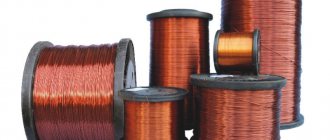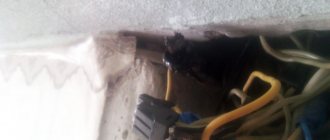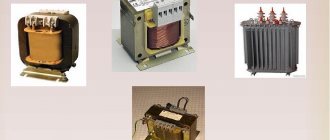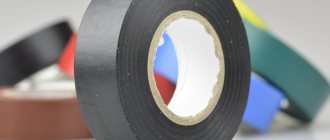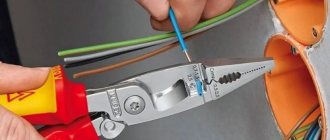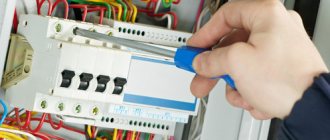Surely you heard in school (if you went to school at all - like me) about these valences of metals, about their incompatibilities, and perhaps even heard about semiconductors.
So, I’ll tell you - don’t twist copper and aluminum , never at all . Well, if, of course, the load currents do not exceed 0.1 - 1 A, then it is possible, but I do not recommend it. This is what we will talk about next with a practical example.
And now in detail. Perhaps you are an experienced and not very electrician and have decided to buy wires for yourself or someone you know. Then they suddenly remembered that you have the Internet at home, and they probably already figured out how to quickly and without headaches make junction boxes, reliably and for 3 kopecks. And they really came up with it!
Wago or twists?
Previously, twists were used everywhere. And they still use it now because it’s more reliable. Then progress has long since stepped forward and invented for humanity - Wago TERMINAL BOARDS . Yes, not simple ones for a screwdriver and a nut with a bolt, but major ones - they are called WAGO terminal blocks and they are produced in various types. For soft and hard wire, for 2.5-4 sq.mm and for 6-8 sq.mm with and without graphite-solid grease.
The price of wago terminal blocks, after the fall of the ruble (thanks Uncle Vov), has become quite steep, but what can you do, after all, the thing is made for people. And the Chinese are great at counterfeiting it.
As a field electrician, I had the opportunity to see how in all sorts of small families, dorms and other residential premises they use twisting of all types of wires and everything. Which of course often leads to overheating and all kinds of burnt contacts, people then sit without light and call ME!
Those same twisted wires that hold all the electrics together.
In general, you should not mix different metals in electrical connections - the risk of fire is very high!
And first of all: There is no need to get involved in electricity at all if you are an amateur. It's dangerous for health.
Wago clamps and copper twist - comparison
09 Feb 2012 News, Expert advice, Home electrical
I have been interested in this question for a long time - really, what is better to use when installing electrical wiring: wago clamps or copper strands?
There are serious disputes on this issue, whole battles flare up))) on the forums, but the truth, as they say, is somewhere nearby.
Personally, I think that there is nothing wrong with using VAG clamps - under certain conditions they are quite applicable.
However, there is one BUT! Since the contact with the wire at the clamp is point-like, in theory the contact resistance should increase compared to twisting.
And besides, it is unknown how the clamp will behave at the limit of its capabilities - at high current and high temperature of the wire.
This is exactly what I decided to check.
I took an installation wire with a cross-section of 2.5 sq. mm, cut it into four equal parts of 15 cm each and connected the two wires - with a twist and two - with a VAG clamp.
new welder, I bought a wago clamp specifically for a cross section of 2.5 sq. mm and a current of 25A.
I decided to determine where the transition resistance is lower in the following way: apply a load to the wire three times greater than the permissible load, so that the wire begins to heat up intensely.
I reasoned this way: if there is a transition resistance on a section of the wire, then the heating in this place will be stronger and the wire insulation will melt in this place earlier than on the rest of the wire section.
All that remains is to detect the time when the insulation near the contact resistance begins to melt and compare the two indicators with each other - at the twist and at the wago clamp.
I’ll say right away that the test results showed the complete superiority of twisting!
So, tests. Supplied a load of 80 Amps. During the heating process of the wire, the current decreased to 76-77 Amperes, as can be seen in the photographs.
And a very important detail:
the twisted wire heated up almost evenly along its entire length, and even at the end of the test it was visually clear that the insulation melted equally, both near the twist and along the length of the wire.
How did I determine this? And you can see where the smoke was coming from))) And it was coming evenly from all over the wire.
The tests were stopped after 170 seconds as soon as the wire insulation near the twist was sintered.
It was the turn of the wire with the VAG clamp. After turning on the load after 96 seconds. smoke came from the clamping area, it was even clear that the smoke was coming from the insulation directly near the wago clamp.
And after 130 seconds, the wire insulation near the clamp was completely melted and sintered.
Conclusion: at high rates of overload current in electrical wiring, twisting is more preferable than wago clamps.
After all, the machine was chosen based on the load in the store! And what will happen in this case in the junction boxes? Naturally, the wire insulation will overheat and even melt, and in this case, the use of wago clamps will only worsen the situation...
I’m not finishing the test here, I’ll come up with something else, and maybe you can suggest something, I’ll do it and show the result.
Write comments, I will be grateful if you click on the +1 and tweet buttons at the top of the article.
Personal experience using the Wago terminal block
I did an experiment at home. In a junction box , which is all on an aluminum wire from the developer. Poe bit off the aluminum and assembled everything on Wago terminals.
The input wires that powered the wiring from the shield were placed on separate “vags” and lined with copper. And this is what happened:
Aluminum wire with a cross-section of 1.5 square millimeters and copper 2.5 square, through the wago terminal block. Black with a graphite-solidol thing inside. It seems like the reliability is almost durable, however.
All this is a violation of “PEU”. It worked for 3-4 years and soldering stations, vacuum cleaners, and soldering hair dryers were used with a bang, no complaints. But when I started running a washing machine from the same line, miracles began to happen. Literally, in a month, after 6-8 washes as usual. The junction box: began to sing, groan, characteristically spark and show signs of instability. Several times even the surge protector went into protection (I have it with surge protection).
The alarm for burning and sparking of the wiring on the Wago terminal blocks rang, I climbed inside and what did I see?
The darkness and trash of this junction box reflects the general standard of living)
The same wago terminal block that leaked but continued to work
Copper to aluminum connection Wago terminal block
BINGO! Everything melted to hell! The whole point is that the connection: copper with aluminum - does not heat up so much under the load of current passing through this connection. As a result, it is clear that the wago terminal blocks have been smashed into mush. Moreover, the copper wire is stuck, and the aluminum dangles like a hair. Of course, the “zero” burned out, but the phase contact also melted.
Types of WAGO terminal blocks
In general, there are a huge variety of terminal blocks and they are produced not only by the WAGO brand, terminal blocks are also made by Legrand and a bunch of other third-party manufacturers, which for some reason have not taken root in Russia. China, of course, does not lag behind and fakes everything with a bang.
The main types of wago terminal blocks are 3 types:
- Reusable terminal blocks - for soft wire;
- “Disposable” with a special paste for mixing aluminum and copper (I call it solid oil-graphite);
- “Disposable” without special paste, the body of which is transparent.
On good terms, all these types are suitable for low-current, fast switching networks, powering: uninterruptible power supplies, power supplies, spotlights, assembling lighting wiring and something from the same low-power series. Well, not for power supply, input wires and power panels with sockets.
Reusable, disposable and wago terminal blocks with paste
Advantages of Vago terminal blocks
Here I will not go into details, since you can find at least some advantages in everything. I'm telling you this as a salesman. I’ll just say what I highlighted myself: the simplicity and speed of installation and dismantling if necessary, as well as aesthetics and beauty . If anyone has anything to add, please leave a review in the comments. Just don’t write about the reliability of the connection, vibration resistance and the like, since spring terminal blocks cannot be more reliable than a screw clamp.
How to use wago terminal blocks
There was also a case when I received a call from a production plant outside the city. A small workshop - a sawmill for 5 and a half Uzbeks. Their electricity was constantly cut off, although all loads did not exceed 5-6 kilowatts. And the supply wire had a reserve of 2-3 times. The power supply panel of this workshop had a 32-amp input circuit breaker (freshly installed), but it was also turned off every half hour or hour. An external examination revealed nothing. And when I already went directly into the contacts, I went nuts. The input wire is aluminum 10 squares, there is also copper 10 squares and there is a copper 3-phase jumper and all this is in one contact of the circuit breaker, of course the plastic melted and caused oxidation to everything that was happening. But look from the outside, everything is fine - a new machine, the wires are laid, no traces of burning.
This shield was defeated by a brass 3-phase closed busbar. Be that as it may, the connection with bolts, even coupled with aluminum and copper, gave a much better effect than wago terminal blocks. People are happy, the workshop is working non-stop, they called and thanked us, and asked us to rebuild another panel.
Insulated brass busbar for 3 phases for DIN rail
Purpose of terminal blocks from Wago
The main purpose of Vago terminal blocks is to simplify electrical installation. For a normal connection of wires, it is necessary to twist, crimp or solder. This takes up valuable time and effort. The use of Vago connectors allows you to connect wires in a matter of seconds.
Connecting wires using Wago clamps
This leads to secondary tasks that can be achieved using terminal blocks:
- increasing the pace of wiring;
- saving insulating materials;
- greater visibility of electrical wiring for repair personnel;
- possibility of operational switching in the circuit;
- quick replacement of damaged electrical installations.
Design and principle of operation of the block
In the basic configuration, the terminal clamp consists of two parts:
- Wire clamping mechanism. Made of tinned electrical copper. The purpose of the clamping mechanism is to secure the cable core and maintain reliable electrical contact between the wires.
- Insulating housing. Made from flame retardant polyamide. Protects people, bystanders and wiring components from contact with the live clamping mechanism.
Additionally, Wago terminal blocks can be equipped with marking plates, built-in diodes and protective sealing covers.
The principle of operation is to clamp the wire with a spring. Some connector models have a special lever (often orange) for this purpose. It is needed to open the mechanism and allow the wire to enter the clamping area. For others, it is enough to simply insert the cable with the tip into the spring mechanism, and it will open on its own.
Note. There are Vago grounding terminal blocks. The wires that connect to them are electrically connected to the DIN rail fasteners. Such pads are used strictly only for grounding. They are easily distinguished by the yellow-green color of the case and metal latches. If you connect a phase wire to such a terminal block, there will be a short circuit to ground and a risk.
WAGO Ground Terminal
Characteristics of Wago
Vago terminal blocks are used both in household electrical wiring and in industrial devices. This explains the wide range of their technical characteristics.
The conductive part of the connector is made of copper. This material conducts electricity well without significant heat losses. The copper is coated with a thin layer of soft tin-lead solder. Its task is to maximize electrical contact with the wiring.
Dimensions of terminal blocks of the car
The terminal block insulation is made of overheat-resistant material. It can withstand temperatures up to 200 °C for a short time. This property is necessary from the point of view of fire safety requirements.
Pros and cons of use
Practicing electricians were divided into two categories. Some focus on the advantages of Vago terminal blocks, while others note mainly the disadvantages. In fact, the truth is somewhere between these two opinions.
Advantages of using Vago:
- quick screwless installation;
- a minimum set of necessary tools and materials;
- the terminal block is easy to buy even in a small electrical store;
- neatness and logic of wiring;
- compliance with safety regulations.
Disadvantages of terminal blocks:
- the need for periodic inspection;
- must be visually accessible;
- do not cope well with loads greater than 1 kW;
- high contact resistance;
- risk of overheating and melting;
- high price.
Conclusion on wago terminal blocks
Wago terminal blocks are a good thing, but they are contraindicated for use on power (socket) lines . Use for lighting and light loads please. Although the manufacturer stated: load retention through wago up to 4 kW. From experience I can say that this connection from the same type of wire (copper to copper) will last for 3-5 years, then the contact will begin to age and deteriorate. Therefore, emotional twists, sealed with solder without acids and aggressive fluxes, are our everything!
The contact area of the wago terminal block greatly loses twisting
wago terminal block burned out melted
Wago terminal block with grease for aluminum and copper
Melted Wago terminal connecting aluminum and copper
